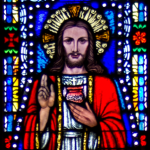In my post for February 12, 2014 (HERE) I laid a foundation for understanding in a positive way the role of imagination in our lives as helping us to image reality; and that in relationship to "God-matters" ("religious realities") part of our imagination involves a "religious imagination." I then began to describe the Catholic Imagination. The most distinctive way that Catholic Imagination is defined is to say that Catholic Imagination is a "sacramental imagination."
.jpg) |
| Moses and the Burning Bush: God is revealed in creation and fire |
1. What is meant by the term "sacramental imagination"? One author notes:
"Thus a sacramental world view [this applies to sacramental imagination], rooted in God's revelation to humanity, especially in the Incarnation, is experiencing God acting within the world in which we live, the world in which God chose to dwell for the sake of our salvation.
"For instance, nature, smells, sights, sounds, people, books, words, etc, can all have a sacramental character, in that God can supply grace, enliven, and enlighten us through diverse physical vehicles. While the classically accepted sacraments are sure means of grace, these [other] "sacramental experiences" are more subjective, and depend more on what God intends to do. E.g., nature does not always have a sacramental character, but can. This depends on God's intended activity in the world, an activity that I tend to see as more of a complex numinous web than anything linear. Why one hiker discovers God through nature, and another scorns God, we cannot know." (See David Bennett, "Sacraments: Meeting God in Our Own World," LINK)
Now when we who are Catholic hear that God uses creation and human relationships and experiences to communicate his life to us, we probably think "Well of course he does!" That’s because this is the nature of the Catholic sacramental imagination. But our Protestant neighbors would be much more cautious about accepting this.
One of the ways we can understand the Catholic sacramental imagination is to contrast it with the Protestant religious imagination or approach to living the Christian faith. It must be always remembered that Catholics and Protestants are both Christian, but have differences in the ways God and the realities of God are imaged (imagined).
2. Thus, in Christ Jesus, the Catholic religious imagination tends to be:
"symbol-friendly" and "creation-friendly"
3. By contrast, the Protestant religious imagination tends to be somewhat "symbol cautious" (and some forms of Protestantism, such as Southern Baptist, are very limited in their use of symbol). The Protestant religious imagination is restrictive in the use of created and human realities, and is thus:
"symbol-cautious" and "creation-cautious"
Another, colloquial way of stating the difference is that Protestants tend to believe that "stuff" can get in the way of knowing God in Christ Jesus. Most Catholics would believe that "stuff" (creation, human relationships, the Church, etc.) is helpful, even essential to knowing God in Christ Jesus.
4. The Protestant religious imagination is mainly nourished by the Bible. Most Protestant churches, if they have sacraments, have two: Baptism and the Eucharist (or "the Lord’s Supper"). The Catholic religious imagination is also nourished by the Scriptures, and through Seven Sacraments, but also in "the stuff" of our world.
Much more has to be explained and I shall return to this topic to teach more about it in the future. Next week, we will be able to examine some images given us in the Season of Lent that are to guide us in our Catholic spiritual journey.


